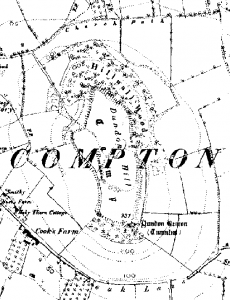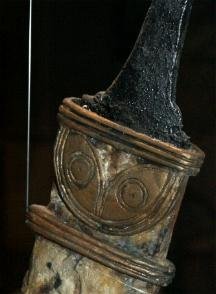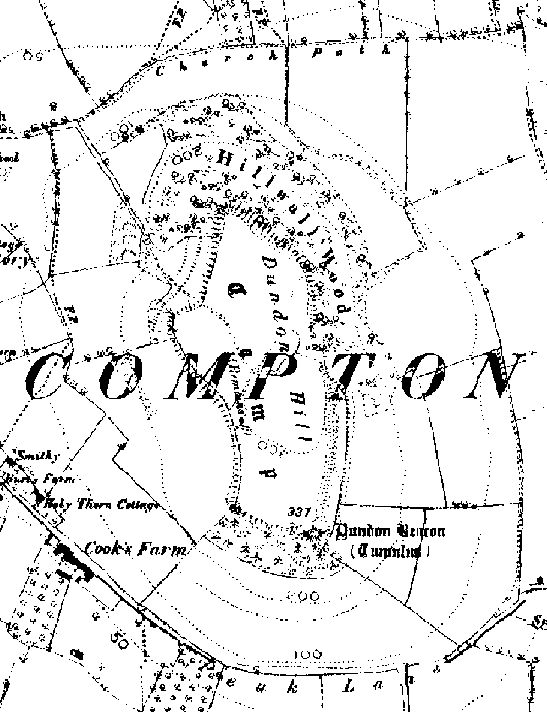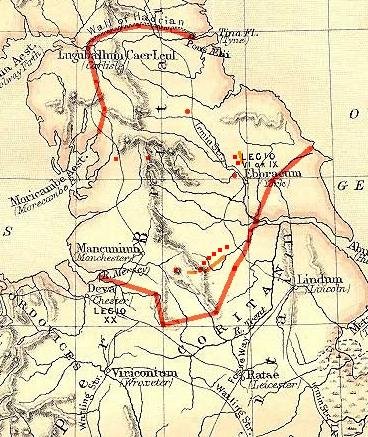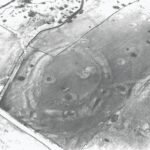Contents
Site Details:
Dundon Hill as it appears on the 1850 OS map.
Description
Historical Notes
There is a plan and short description in volume 2 of the Victoria County History for Somerset (pages 490-1).
Ian Burrow's Hillfort and Hill-top Settlement in Somerset in the First to Eighth Centuries has a more recent (but less detailed) description at p 214.
It's about 4.8 ha in area and univallate. No excavations seem to have been carried out though before the First World War flint and pottery scatters were found there.
Scheduled Monuments OBJECTID 43789 Reference SO22076 Name COMPTON DUNDON HILLFORT WITH DUNDON BEACON, EAST OF DUNDON Suffix OBJECTID 43789
Other Notes:
Local Myths and Legends
The area around Dundon Hill Hillfort, including the broader region of Somerset, is rich in myths, legends, and folklore that help to shape its sense of place. These stories often reflect the cultural and spiritual importance of the land, and many are connected to ancient traditions, landscapes, and landmarks in the region. Here are some of the most notable myths and legends that provide context to the area:
King Arthur and Glastonbury
Glastonbury Tor and Avalon: Just to the northeast of Dundon Hill Hillfort lies the famous Glastonbury Tor, a hill that has long been associated with the legend of King Arthur and the mystical island of Avalon. According to Arthurian legend, Glastonbury Tor is thought to be the site of Avalon, where King Arthur was taken after his final battle to heal from his wounds. The Tor is often depicted as a place of magical power, tied to the ancient beliefs of the Celts and their reverence for the land.
The Quest for the Holy Grail: Glastonbury also features prominently in the legend of the Holy Grail, with some stories suggesting that Joseph of Arimathea brought the Grail to Britain and that it was hidden in the area. This association ties the land to both Christian and pagan mythologies, creating a rich tapestry of spiritual significance.
The Glastonbury Zodiac
The Glastonbury Zodiac is a concept that links various sites in the area, including Dundon Hill Hillfort and Glastonbury Tor, through astrological and ley line connections. The idea is that the land itself forms the shape of a giant zodiac, with each landmark representing a different part of the astrological map. Some interpretations suggest that these alignments were intentional, serving as a form of ancient spiritual or mystical map, connecting people to the cosmos and divine forces. While largely speculative, this myth offers a fascinating lens through which to view the landscape and its significance.
The White Horse of Somerset
Not far from Dundon Hill, there are several chalk hill figures, including the famous White Horse of Uffington in Oxfordshire. The White Horse, often linked to ancient pagan rituals, is said to represent a Celtic or pre-Celtic goddess. Some believe that the figure’s role was to mark sacred land or serve as a symbol of fertility and renewal. Although the Uffington White Horse is the most famous, similar figures can be found throughout the southwest, adding a sense of continuity with ancient customs tied to the land.
In Somerset, the Mendip Hills and Cheddar Gorge have also been part of this tradition, with the white horse symbol evoking a connection to both the landscape and the divine.
The Legend of the Lady of the Lake
In the folklore surrounding King Arthur, the Lady of the Lake is often described as a mystical figure who lives in a lake and is closely associated with Avalon. Though the specific location of the Lady’s lake varies in different versions of the story, it is widely believed that Glastonbury Lake (now a marshy area near the town) was once considered the home of the Lady of the Lake. Some legends also suggest that the sword Excalibur was retrieved from this lake, further intertwining the region with the Arthurian narrative.
Chalice Well, a sacred spring in Glastonbury, is also associated with this legend. Its waters are said to possess healing properties, linking the area to both the myths of King Arthur and older pagan beliefs surrounding water as a life-giving force.
The Beast of Exmoor
A more recent addition to the legends of the Somerset area, the Beast of Exmoor is an elusive creature that some claim to have seen roaming the Exmoor National Park. Described as a large, panther-like animal, the Beast is said to have been roaming the moorland since the 1970s, with occasional reports of sightings. Whether real or mythological, the Beast has become part of the local folklore, symbolizing the untamed and mysterious nature of the Somerset wilderness.
The legend also evokes the older archetypes of wild animals in Celtic and pre-Celtic myth, where certain creatures were believed to have spiritual significance or were seen as guardians of sacred places.
The Witches of Somerset
Somerset has long been associated with witches and magic. The Witchcraft Act of 1735 was passed in response to growing concerns about witchcraft in the region. It is said that many witches were believed to live in the remote areas of the county, and the Polden Hills (near Dundon Hill) are said to have been home to several notorious witches.
Legends about witches casting spells, flying on broomsticks, and interacting with the land’s natural spirits still persist in the folk traditions of the area. These stories often intertwine with the land’s natural features, such as ancient trees, caves, and springs, believed to be places of power where witches could tap into the energies of the earth.
The Tale of the Perilous Chapel
A local legend associated with the Dundon Hill area tells of a chapel or church, known as the Perilous Chapel, that once stood on the hill. It is said that the chapel was a place of healing, but also a place where individuals could find themselves at the mercy of powerful supernatural forces. Those who ventured there in search of spiritual enlightenment were said to sometimes disappear, their fates linked to the dark forces of the hill.
Although no physical remains of this chapel have been found, the legend contributes to the sense of mystery surrounding the area, casting Dundon Hill and its surroundings as places of spiritual significance, both light and dark.
Conclusion
The myths and legends surrounding Dundon Hill Hillfort and the broader Somerset area provide a deep sense of place, connecting the land to ancient traditions, spiritual practices, and a mystical past. From King Arthur’s Avalon to the eerie tales of witches and wild beasts, these stories enrich the landscape and offer insights into the ways ancient peoples viewed their world—blending the natural with the supernatural in a way that continues to captivate the imagination today. These legends help reinforce the historical and spiritual weight of the region, highlighting its importance not just as a physical space but as a place rich with cultural and mystical significance.
Site Gallery
Gallery Empty

